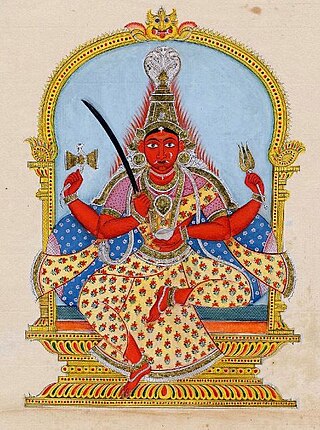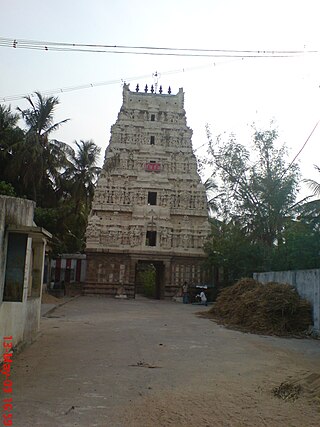
Mariamman, often abbreviated to Amman, is a Hindu goddess of weather, predominantly venerated in the rural areas of South India. Her festivals are held during the late summer/early autumn season of Ādi throughout Tamil Nadu and the Deccan region, the largest being the Ādi Thiruviḻa. Her worship mainly focuses on bringing rains and curing diseases like cholera, smallpox, and chicken pox. Mariamman is worshipped in accordance with local traditions such as Pidari or the Gramadevatai. She is considered as a guardian deity by many South Indian village-dwellers.

The Sri Mariamman Temple is Singapore's oldest Hindu temple. It is an agamic temple, built in the Dravidian style. Located at 244 South Bridge Road, in the downtown Chinatown district, the temple serves the majority Hindu Singaporeans, Tamilians, in the city-state. Due to its architectural and historical significance, the temple has been gazetted a National Monument and is a major tourist attraction. Sri Mariamman Temple is managed by the Hindu Endowments Board, a statutory board under the Ministry of Community Development, Youth and Sports.
Namagiripettai is a panchayat town in Namakkal district in the Indian state of Tamil Nadu.

The Arulmigu Sri Mahamariamman Temple is a Hindu temple within George Town in the Malaysian state of Penang. The oldest Hindu temple in the state, it was built in 1833, and features sculptures of gods and goddesses over its main entrance and facade.

Veerapandi is a panchayat gram in Theni district in the Indian state of Tamil Nadu.

Arulmigu Sri Mariamman Temple, Samayapuram is an ancient Hindu temple in Tiruchirappalli district in Tamil Nadu, India. The main deity, Samayapuram Mariamman, a form of Adi Parashakti and Mariamman, is made of sand and clay with extractions of medicinal herbs unlike many of the traditional stone idols and is considered as most powerful Goddess, and hence unlike many other Hindu deities there are no abhishekams conducted to the main deity, but instead the "abishekam" is done to the small stone statue in front of it.

The Thimithi or firewalking ceremony is a Hindu festival originating in Tamil Nadu, South India that is celebrated a week before Deepavali, during the month of Aipasi of the Tamil calendar. The fire-walking ceremony is in honour of the goddess Draupati Amman, who is considered the incarnation of goddess Mariamman, and is practiced not only in India, but also in countries with large Tamil populations like Sri Lanka, Fiji, Singapore, Malaysia, Mauritius, Réunion, South Africa and others.
Vazhmangalam is a small village located on the border between Tamil Nadu and Puducherry in India. The nearest place in Puducherry is T. R. Pattinam.

Thenupuriswarar Temple is a Hindu temple dedicated to the god Shiva located in the village of Patteeswaram, Tamil Nadu, India. Shiva is worshiped as Thenupuriswarar, and is represented by the lingam. His consort Parvati is depicted as Nyanambikai (Somakamalambigai). The presiding deity is revered in the 7th century Tamil Saiva canonical work, the Tevaram, written by Tamil saint poets known as the Nayanars and classified as Paadal Petra Sthalam. The temple is associated with the legend of Sambandar to whose view Nandi moved to have a direct view of the presiding deity. Muthupandal festival celebrated in the temple in associated with the legend.

Sri Maha Mariamman Temple, also known as Maha Uma Devi Temple (Thai: วัดพระศรีมหาอุมาเทวี; RTGS: Wat Phra Si Maha Umathewi and Wat Khaek in Thai, is a South Indian architecture style Hindu temple on Si Lom Road in Bangkok, Thailand. It was built in 1879 by Vaithi Padayatchi, a Tamil Hindu immigrant.

Arulmigu Sri Bannari Mariamman Temple is an Amman temple in the Indian state of Tamil Nadu. It is located near Sathyamangalam, Erode district.
Avathuvadi is a town in Krishnagiri District, Tamil Nadu, India. It is located on the banks of the river Thenpennai, about 13 kilometres (8.1 mi) from Kaveripattinam and 7 kilometres (4.3 mi) from Karimangalam. The town is governed by a gram panchayat.

The Ettampadai is a temple of Lord Murugan (Subrahmanya) in India, located in the neighbourhood of Triplicane (Thiruvallikkeni) in Chennai.
The flower festival or flower sprinkling festival is an important festival celebrated in the Samayapuram Mariamman temple near Tiruchirappalli, India. This festival is usually held in the Tamil month of Masi. During this festival, devotees throng the temple to sprinkle flowers on the idol of the Hindu goddess Mariamman. During this period, it is believed, that the goddess fasts for the welfare of her devotees for a period of 28 days. As a result, the ritual consecration of food at the temple does not take place.
Veppur is a block in the perambalur district of Tamil Nadu, India. Total 33 villages in veppur block in kunnam Taluk
Manadu Thandupathu is an Indian village in Thoothukudi district near Tiruchendur above 12 km. It is famous for 'Pathene'.

Sri Mariamman Temple is Medan's oldest Hindu Temple. This temple was built in 1884 for the worship of Goddess Mariamman. The temple is situated in the area known as Kampung Madras or Medan's Little India. This temple is also devoted to the Hindu Gods Ganesha, and Murugan, children of Mariamman. The Gate is decorated by gopuram, namely storey tower which can usually be found at the gate of the Hindus temples in South India. The temple is a meeting point for worshippers during Thaipusam and Deevapali festivals.

Anbil is a village in India's Tiruchirappalli district, close to Lalgudi, and situated on the banks of the Kollidam River.

Periya Mariamman Temple is located near Panneer Selvam Park, opposite to Erode Corporation Building in the city of Erode, Tamil Nadu, India. It is dedicated to Mariamman, the Hindu Goddess. Kongu Cholas built the temple 1200 years ago.
Thanjavur Palace Devastanam is the name of a group of temples attached to the Palace Devastanams, Thanjavur, Tamil Nadu, India.













